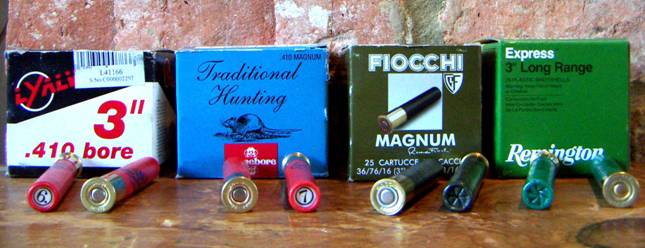
|
Lyalvale 9/16oz/16gm
H-27 Reversible wad
|
Gamebore 9/16oz/16gm
H-27 Reversible Wad
|
Fiocchi 11/16oz/19.5gm
Full length wad
|
Remington 11/16oz
3/4 length wad
|
In addition to the factory loads my pet heavy hunting loads were tried
with excellent results on everything from Pigeons and Crows to fast
running Rabbits and Squirrels. With a full house payload of 3/4oz (21.27gm)
of shot these shells really are the ‘bees knees’ for maximum hunting
potential. I load with either UK#5, 6 or 7 shot depending on the occasion
(2.8, 2.6 & 2.4mm).
However for situations where the likely quarry is undetermined UK#6
seems to be a good compromise, dropping big crows with authority out
to full distances for this type of gun. With the PC Orange wad and 4%
antimony shot these ‘beasties’ clock a genuine 1125fps at 3 feet from
the muzzle. This is achieved without undue pressure levels, which always
destroy the pattern potential with a given load.
The propellant choice is a European rifle number, which is a double-based
ball type, with smooth highly progressive burning rates and the ability
to produce excellent, dense, well distributed patterns with top end
loadings such as this (Hodgdon H-110 can also be used with this load).
Case life is good without the mouth erosion so often seen in some European
heavy .410 shells.
This is usually due to raised pressure levels and the wrong wad choice
for the job at hand. High frictional forces of the shot onto the case
walls can and do render the case mouths utterly inadequate, with sizable
chunks being ripped away upon firing in some cases. Short wads with
little or no shot cup are a particular problem here. Case mouth integrity
is clearly important if the fired shells are to be reloaded, with the
lubrication of the shot being a very good idea when loading with fibre
and the reversible types of wad, with various products available.
|
16mm capped cork wad
|
H-21 reversible wad
|
H-27 reversible wad
|
|
|
|
|
For maximum case life full-length cup container wads are
to be recommended, however the shorter cup wads like the H-27 NANA (not
to be confused with the H-27 reversible wad) are a very good choice
for skeet and sporting clay loads in the 2½ inch plastic parallel tubed
cases.
They combine a good central core density together with a better peripheral
spread in the outer pattern zones. Choke choices are very much the key
issue here to achieve the desired patterning effects. (See the .410
annual: ‘Because Its there’ ‘Climbing the North face of the .410’).
With the 870 pump my choice for Skeet and medium sporting
clay targets was to get as much spread as was feasible with the improved
modified choke (UK ¾). Using fairly soft shot at 2% antimony content
and the capped fibre and the two reversible wads shown above satisfactory
1/2oz skeet loads were possible using Hodgdon Lil’Gun, HS7, H-4227,
H-110, Alliant Blue Dot, 2400, ‘.410’ and Nobel Sport Vectan SP3 powders.
The major down side was the inevitable resultant barrel
leading, but the cork wad did a fairly good job of keeping the levels
down to a tolerable level. The lower flame temperatures developed with
H-4227 (being a single based powder) were also helpful in this regard,
reducing the degree of residual leading.
The best spreading load from this point of view
was the 16mm cork wad, 1/2oz of 2% antimony (chilled shot in the US)
#9 shot preferably with some sort of lube, Fiocchi or Cheddite plastic
73mm case with Cheddite 209 primer (known as the Cheddite CX2000 in
the UK), 17-18grains of H-4227and finished with a star crimp for 1185-1225fps
@ 3feet.* See Warning.
The only real problem with using H-4227 is its relative
bulk compared with other powders, but being of a single based composition
(containing no proportion of nitro glycerine in its make up) this is
hard to avoid.
© Light Gauges Publications, 2 Carrington Hall Road, Drayton
Parslow, Bucks, UK, MK17 0JP
Email: [email protected]